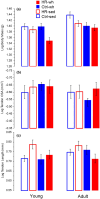Early-life exercise effects on Achilles tendon in mice selectively bred for high voluntary wheel-running behavior
- PMID: 40827110
- PMCID: PMC12361812
- DOI: 10.14814/phy2.70515
Early-life exercise effects on Achilles tendon in mice selectively bred for high voluntary wheel-running behavior
Abstract
Exercise increases muscle and bone strength and mass, but effects on tendons are less documented. We investigated the impact of voluntary exercise (wheel running) during early-life exercise (weanling; 3 weeks old) compared to post-skeletal maturity (young adult; 9 weeks old) on tendon morphology and material properties. We utilized a selectively bred High Runner (HR, N = 40) mouse line and a control line (N = 40). Mice underwent 8 weeks in cages either with or without wheels. HR mice ran ~3-fold more and were smaller than controls, but exercise reduced body mass in both lines. Tendon cross-sectional area was unaffected, but tendon length showed a line*exercise interaction (p = 0.0410) and a near-significant line*age interaction (p = 0.0866). HR mice broadly had greater yield stress (p = 0.0262) and tended toward higher failure stress (p = 0.0676) than controls. Work to failure was greater in younger cohort mice (p = 0.0435), and marginal age-related interactions were observed for modulus (line*exercise, p = 0.0632) and yield strain (line*age, p = 0.0535). HR mice were more responsive to exercise; older exercised HR mice had shorter tendons (p = 0.0282), and younger exercised HR mice showed lower yield and failure strains than sedentary counterparts (p = 0.0445, 0.0246). Exercise and its relative timing produced slight but complex effects on tendon properties, with HR mice showing the strongest structural and mechanical responses.
Keywords: artificial selection; biomechanics; locomotion; maturation; tendon; wheel running.
© 2025 The Author(s). Physiological Reports published by Wiley Periodicals LLC on behalf of The Physiological Society and the American Physiological Society.
Figures





Similar articles
-
Hippocampal long-term potentiation is modulated by exercise-induced alterations in dopaminergic synaptic transmission in mice selectively bred for high voluntary wheel running.Restor Neurol Neurosci. 2024 Nov;42(3-4):193-208. doi: 10.1177/09226028241290400. Epub 2024 Nov 4. Restor Neurol Neurosci. 2024. PMID: 39973602
-
Optimisation of antiretroviral therapy in HIV-infected children under 3 years of age.Cochrane Database Syst Rev. 2014 May 22;2014(5):CD004772. doi: 10.1002/14651858.CD004772.pub4. Cochrane Database Syst Rev. 2014. PMID: 24852077 Free PMC article.
-
Return to Running After Achilles Tendon Repair: How Do US Navy Service Members' Physical Readiness Tests Change After Undergoing an Achilles Tendon Repair?Clin Orthop Relat Res. 2025 Jun 18. doi: 10.1097/CORR.0000000000003590. Online ahead of print. Clin Orthop Relat Res. 2025. PMID: 40536551
-
Shared and distinct adaptations to early-life exercise training based on inborn fitness.J Physiol. 2025 Jun 15. doi: 10.1113/JP288331. Online ahead of print. J Physiol. 2025. PMID: 40517393
-
Physical exercise training interventions for children and young adults during and after treatment for childhood cancer.Cochrane Database Syst Rev. 2016 Mar 31;3(3):CD008796. doi: 10.1002/14651858.CD008796.pub3. Cochrane Database Syst Rev. 2016. PMID: 27030386 Free PMC article.
References
-
- Almekinders, L. C. , & Deol, G. (1999). The effects of aging, antiinflammatory drugs, and ultrasound on the in vitro response of tendon tissue. The American Journal of Sports Medicine, 27, 417–421. - PubMed
-
- Arampatzis, A. , Karamanidis, K. , Morey‐Klapsing, G. , De Monte, G. , & Stafilidis, S. (2007). Mechanical properties of the triceps surae tendon and aponeurosis in relation to intensity of sport activity. Journal of Biomechanics, 40, 1946–1952. - PubMed
-
- Arampatzis, A. , Peper, A. , Bierbaum, S. , & Albracht, K. (2010). Plasticity of human Achilles tendon mechanical and morphological properties in response to cyclic strain. Journal of Biomechanics, 43, 3073–3079. - PubMed
-
- Barin, F. R. , Durigan, J. L. Q. , Oliveira, K. D. , Migliolo, L. , Almeida, J. A. , Carvalho, M. , Petriz, B. , Selistre‐de‐Araujo, H. S. , Fontes, W. , Franco, O. L. , & Marqueti, R. D. (2017). Beneficial effects of resistance training on the protein profile of the calcaneal tendon during aging. Experimental Gerontology, 100, 54–62. - PubMed
-
- Bartling, B. , Al‐Robaiy, S. , Lehnich, H. , Binder, L. , Hiebl, B. , & Simm, A. (2017). Sex‐related differences in the wheel‐running activity of mice decline with increasing age. Experimental Gerontology, 87, 139–147. - PubMed
Grants and funding
LinkOut - more resources
Full Text Sources
Miscellaneous

